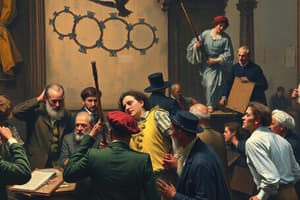Podcast
Questions and Answers
What is a key characteristic of a strike?
What is a key characteristic of a strike?
- It is a spontaneous individual decision to stop working.
- It is carried out by employees of different companies only.
- It requires prior approval from the employer.
- It involves a refusal to work as a collective action. (correct)
Which of the following is NOT a reason for strike action?
Which of the following is NOT a reason for strike action?
- Desire for organizational ranking (correct)
- Dissatisfaction with conditions of service
- General dissatisfaction among employees
- Solidarity with other employees
What type of strike occurs suddenly without prior warning?
What type of strike occurs suddenly without prior warning?
- Picketing
- Wildcats strike (correct)
- Overtime ban
- Sympathy strike
Which method best describes holding production without stopping operations completely?
Which method best describes holding production without stopping operations completely?
What is the primary purpose of sympathy strikes?
What is the primary purpose of sympathy strikes?
Which factor is NOT considered a contributing factor to strikes?
Which factor is NOT considered a contributing factor to strikes?
What is one of the key differences between a protected strike and an unprotected strike?
What is one of the key differences between a protected strike and an unprotected strike?
What must be provided for a strike to be classified as protected?
What must be provided for a strike to be classified as protected?
What is a common form of employee action aside from striking?
What is a common form of employee action aside from striking?
Which of the following describes a lockout?
Which of the following describes a lockout?
Which of the following is a legal requirement before embarking on a strike if the employer is a public service?
Which of the following is a legal requirement before embarking on a strike if the employer is a public service?
What is considered a significant change in labor market trends during the COVID-19 era?
What is considered a significant change in labor market trends during the COVID-19 era?
What is a potential consequence of unprotected strikes?
What is a potential consequence of unprotected strikes?
What is a characteristic of essential services?
What is a characteristic of essential services?
Which statement accurately describes minimum services during a strike?
Which statement accurately describes minimum services during a strike?
What is NOT a purpose of a contingency plan during a strike?
What is NOT a purpose of a contingency plan during a strike?
How should the SAPS intervene during a strike?
How should the SAPS intervene during a strike?
Which action is part of an effective action plan during a strike?
Which action is part of an effective action plan during a strike?
What should be done after a strike to ensure agreement fulfillment?
What should be done after a strike to ensure agreement fulfillment?
Which of the following represents a common misconception about maintenance services?
Which of the following represents a common misconception about maintenance services?
What is required when negotiating with striking workers?
What is required when negotiating with striking workers?
Flashcards
Strike definition
Strike definition
A temporary, collective refusal to work by employees to pressure employers to address demands related to grievances or disputes.
Reasons for strikes
Reasons for strikes
Strikes happen due to a variety of reasons including employee dissatisfaction, poor working conditions, economic concerns, and lack of consultation.
Wildcat strike
Wildcat strike
A strike that happens unexpectedly and without authorization.
Sit-down strike
Sit-down strike
Signup and view all the flashcards
Picketing
Picketing
Signup and view all the flashcards
Factors contributing to strikes
Factors contributing to strikes
Signup and view all the flashcards
Work to rule
Work to rule
Signup and view all the flashcards
Withdrawal of co-operation
Withdrawal of co-operation
Signup and view all the flashcards
Product and services boycotts
Product and services boycotts
Signup and view all the flashcards
Lockout
Lockout
Signup and view all the flashcards
Protected strike
Protected strike
Signup and view all the flashcards
Unprotected strike
Unprotected strike
Signup and view all the flashcards
Legal requirements for protected strike
Legal requirements for protected strike
Signup and view all the flashcards
Short notice period, reason?
Short notice period, reason?
Signup and view all the flashcards
Essential Services
Essential Services
Signup and view all the flashcards
Maintenance Services
Maintenance Services
Signup and view all the flashcards
Minimum Services during strike
Minimum Services during strike
Signup and view all the flashcards
SAPS role during a strike
SAPS role during a strike
Signup and view all the flashcards
Contingency plan purpose
Contingency plan purpose
Signup and view all the flashcards
Action plan for strike
Action plan for strike
Signup and view all the flashcards
Aftercare for strike
Aftercare for strike
Signup and view all the flashcards
Study Notes
Industrial Action
- A strike is a temporary, collective refusal to work, to compel an employer to address employee demands.
- According to the Labour Relations Act (LRA), section 213, a strike is a partial or complete refusal to work, hindering work, by employees, to resolve a grievance or disagreement.
- Key elements of a strike include the collective refusal to work and the grievance or dispute that motivates the action.
Reasons for Strike Action
- Dissatisfaction among employees
- Adversarial relationships
- Economic concerns
- Dissatisfaction with work conditions
- Solidarity with other employees
- Personal problems
- Socio-economic issues
- Lack of consultation
- Need to demonstrate strength
- Trade union rivalry
Types of Strikes
- Sit-down: Employees remain at their work station to prevent management from replacing them.
- Wildcat: Strikes that occur without prior warning, often spontaneously.
- Sympathy: Employees from the same company or industry strike in support of workers in another dispute.
- Overtime bans: Employees refuse to work overtime to pressure employers to improve wages.
- Go-slow: Employees deliberately work at a slower pace to put pressure on employers.
- Picketing: Workers demonstrate outside the workplace to publicize their dispute.
Factors Contributing to Strikes
- Location
- Legislation
Protected and Unprotected Strikes and Lockouts
-
Protected strikes: Employees cannot be dismissed for participating. Requires certification from CCMA that conciliation has failed, and referral to bargaining council or CCMA if refusal to bargain. If the employer is public service, the employer must be served notice of proposed lockout or strike.
-
Unprotected strikes: Strikes without necessary statutory requirements; employees who participate may be dismissed.
Labour Market Trends and Unrest in COVID-19 Era
- Shift to remote work
- Retrenchment
- Collective bargaining
- Reduced compliance with labour standards
- Precarious employment
- Impact on women
Essential Services
- Essential services are crucial for maintaining safety and well-being of communities (e.g., medical, fire services). Any interruption may endanger lives.
Maintenance Services
- Maintenance services must not be interrupted as this could cause physical damage to the working area, plant, or machinery.
Minimum Services
- Minimum services are essential to safeguard life, health and personal safety during a strike.
Handling Strikes
- Contingency planning aims to minimize negative impacts of strikes.
- Negotiate with striking employees.
- Protect people and property.
- Formulate guidelines for striking employees.
- Establish a uniform policy and plan of action.
- Arrange for continuation of production (or shutdown).
- Man key positions
Aftercare
- Agreements and promises must be upheld.
- Prevent future conflicts by improving communication channels.
- Measures to avoid recurrences should be placed.
- After a cooling-down period, arrangements for follow-up should be made.
Studying That Suits You
Use AI to generate personalized quizzes and flashcards to suit your learning preferences.
Related Documents
Description
This quiz delves into the concept of industrial action, focusing on strikes as a collective refusal to work. It covers the reasons behind strikes, the different types of strikes, and the legal framework governing them. Test your knowledge on how strikes impact employee relations and organizational dynamics.




